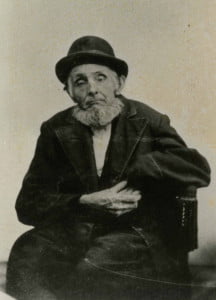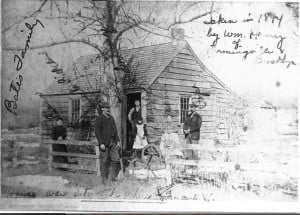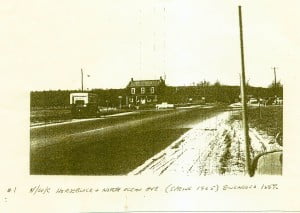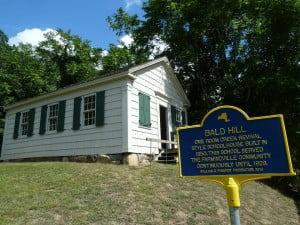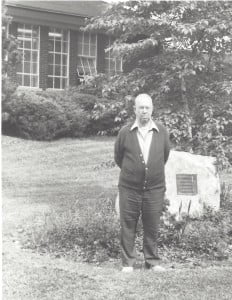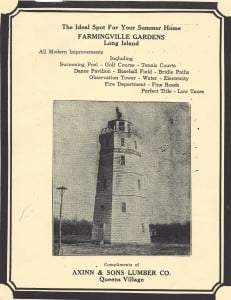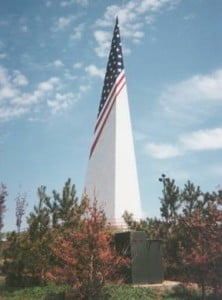History of Farmingville at Sachem Library
With over 80 guests in attendance, the Farmingville Historical Society presented the History of Farmingville at Sachem Public Library.
Farmingville was known as South Koram Hills, Hamlet of Bald Hills, Mooney Ponds and became known as Farmingville around 1900. The area was settled in 1783 by Brewster Terry. Within 10 years there were 5 houses in the town of Bald Hills. The earliest homes said to be built between 1790 and 1797 were owned by Daniel Terry, Brewster Terry, David Overton and the Hammond Family. In 1749 Daniel Terry became the first tax payer in Brookhaven. Here you can see the original deed. Daniel Terry was deeded 1000 acres for 17 shillings and 10 pence, an amount equal to 7 or 8 days wages for a craftsman in the building trade.
Elijah Terry, son of Timothy Brewster Terry and Elizabeth Davis Terry, was born near Coram Village, February 14, 1787 where his parents had a homestead. When Elijah Terry began his teaching career he was teaching students in his father’s house. His first class was made up of 7 boys.
Elijah married Caroline Overton Terry and built their 1823 home known today as the Terry House, on Farm to Market Road. It was about 300 feet to the East of College Road. The two- story house consisted of 4 rooms with a central three-sided fireplace on the first floor with two rooms upstairs. Elijah and Caroline had 4 children.
Elijah Terry was credited with being the first teacher in Bald Hills. Part of his salary was his care and supply of wood to keep the school decently warm. He was a scholarly person and wrote his own books. There is record of an arithmetic book written by Elijah in the early 1800s. He was also a farmer as teachers received little pay in those days.
Elijah Terry died in 1850, the same year the Bald Hills Schoolhouse was opened.
The first schoolhouse in Farmingville was built in 1812, due to legislation set forth in Albany, NY that every child must attend school and a school must be built within a 4 mile radius. The school was sold to James Clark and moved to the point of Horseblock Road and Portion Road. It then became part of the home of the Bates Family and Gertrude Clark, the grandmother of Elmer Fogerty. It was moved west of the schoolhouse on the Fogerty property and in later years it burned.
Members of the Bates family pose for a photo with one of their prized possessions, a spinning wheel. Farm families made their own clothes. A spinning wheel was used to twist yarn so that it could be made into cloth.
A toll road once ran past Bald Hill in Farmingville, stretching for 15 miles from Patchogue to Port Jefferson but it was a toll road used only for bicycles. One of the more challenging sections of the road as described by bikers was one that went north past Granny Road. “Here it became a wilderness trail, passing near Danger Hill (now the site of the Vietnam Memorial)”.
The name Horseblock Road is an old one dating back to the Revolution, when most homesteads along the road had stone or wooden blocks in front of their homes that were used for mounting or dismounting their horses. On several spots along the road, there were blocks for the convenience of stagecoach passengers. The blocks were commonly used as meeting places.
The Granny for whom the Granny Road was named was a legendary woman. Her name was Esther Penny. She was very well known as a local doctress. In earlier times she might have been taken for a witch because she road a fast horse and always wore a red camelot wool cape, probably made from the wool of her own sheep. She was a beloved doctress attending to those in need from Coram to Yaphank, She doctored the sick, drew blood to reduce fevers, brought babies into the world, mended broken bones. She compounded medicines from the herbs she grew in her garden. This angel of mercy died in 1837 at the age of 103. The next time you see a street sign saying Granny Road, think about the amazing lady who traveled this same road two hundred years ago, on her flying steed, on a long forgotten errand of mercy.
The one room Greek Revival 1850 Schoolhouse served the community of Farmingville from 1850 to 1929.The Schoolhouse was heated by a pot-bellied stove that was fed with cordwood. Older boys were responsible to feed the stove during the day. Children brought their lunch in either a tin pail or a tin box, a cane basket box or the lunch was simply wrapped in a cloth. Some students would bring soup for lunch and put it on the stove to keep warm. Baked potatoes were often heated on the stove to serve to warm cold hands as well as provide hot lunch on a cold day.
There were two outhouses behind the Schoolhouse; one for boys and one for girls. After the invention of chemical toilets; the outhouses were replaced with a small addition to the rear of the Schoolhouse containing the chemical toilets.
The Schoolhouse was originally furnished with long wooden benches for seating. Students rotated to the front of the class when it was their turn to take lessons. Older pupils sat facing desks attached to the wall. Toward the end of the century long benches were replace with double wide wood and metal desks nailed to the floor.
A water crock held drinking water for the students who brought their own drinking cups from home. Older boys were responsible to fill the water crock each day. Recollections of former students, Elmer Fogerty and George Holms tell the story of frogs being put into the well to scare the girls. They also tell of the harsh punishments they received by their teacher for their pranks.
Education focused on reading, writing, arithmetic and morals through stories and the Bible. Memorization was important for spelling bees. The rules were to be on time, do your homework, be quiet, do as you were expected to do, not speak unless you were spoken to, and the 3 most important words were to OBEY THE TEACHER. Teaches had to be strict to show strength of character or the unruly boys would take advantage.
Teachers who did not live locally would room within student homes. 11 teachers lived in Farmingville through the years.
In later years, the children pledged the Allegiance to the Flag and prayed each morning. Bible readings were also held as the Bible was used for many lessons. The students of the one room schoolhouse were probably better prepared to read the literary works of writers such as Walt Whitman. Operas, hymns and Greek choruses were a normal part of the general education.
Since 1885 Bald Hills students and their families have held an annual picnic on the Schoolhouse grounds. At the 1929 Annual Picnic, friends were saddened by the thought that it might be their last reunion at the old Schoolhouse. It was J. Grant Smith who suggested that an association be formed for the purpose of buying the 1850 Schoolhouse which was scheduled to be sold at auction. Mrs. Wendell Still, of Selden was empowered to buy the schoolhouse and the 2 1/4 acre grounds. Shares were sold to friends and families of the students who attended the schoolhouse in order to raise enough money to buy the Schoolhouse and in doing so, the Farmingville Reunion Association was created.
The Congregational Church of Farmingville was formed in 1858. They used the Bald Hill Schoolhouse for services until 1890 when they built the Congregation Church of Farmingville with funds donated by the Terry Family.
Septer Terry, born 1866, the grandson to Elijah Terry attended the one-room schoolhouse. Septer Terry had to leave school at 12 years old to help support his brother and 3 sisters when his father died of influenza in 1879. Septer was the first person in Farmingville to have electricity in June 1920. He also had the first telephone in Farmingville in October 1919. Septer was a farmer at heart but held the office of town assessor, was very successful in real estate and was a school trustee for 31 years. He was pivotal in the consolidation of the Holtsville and Farmingville school districts and for the erection of the brick school house (known now as Waverly Avenue School)
In 1928, the people of district 13 voted to consolidate Farmingville School District with Holtsville School District 35. The following year, 1929, the new Waverly Avenue School (formerly called Holtsville School) was built on Waverly Avenue, midway between Farmingville and Holtsville. Students from grade 1 though 8 attended the new four-room school.
Farmingville and Holtsville students planning to attend high school still had to travel to Patchogue for classes. With the introduction of school buses in 1929, students were able to travel to school easily.
Elmer L. Fogerty, born 1905, became the bus owner-operator in 1936-1937 for the Holtsville-Farmingville School District when he bought the seven-seated passenger car contract from William Wild who held the original contract for $3,700 in 1935-1936 to take the Holtsville-Farmingville students to the Patchogue High School when Patchogue phased out their program of accepting students outside of their district, the Holtsville-Farmingville students came to Bayport High School in 1936-1958. When Sachem High School was built in 1955, the Holtsville-Farmingville students were given the option to finish out their high school years in Bayport.
Elmer Fogerty was one of the first bus owners to hire women. He felt that women were more ‘immune’ to the noise, safer with the kids, didn’t drink and had more control. Mary Tingen, the first to drive for him, was given no special treatment and drove for 14 years.
Years ago Mr. Fogerty had a way of keeping the students well mannered and orderly by stopping 2 or 3 times per week at the Carvel Ice Cream Store. Flying saucers were 10 cents!!
One other fun fact – George Fogerty Sr. was a chauffeur to the actress Maude Adams whenever she was staying at her home on Cenacle Road, Ronkonkoma.
The land for Hanrahan Farmingville Gardens was purchased from Septer Terry (grandson of Elijah Terry).
In 1929, Hanrahan Nature’s Gardens was planned on Harahan Avenue, Farmingville. The streets were named for the Harahan children. In 1932, the Hanrahan’s summer house was built on the Northwest corner, south of Farm to Market Road (horseblock road). The community had a dance pavilion, tennis court, Swimming pool, recreation room, water tower/viewing tower, firehouse and fire truck.
The Hanrahan Firehouse still stands on the private property across from the Historic Schoolhouse and can its current state can be seen in the photos. The Farmingville Historical Society is exploring whether it can be moved to and preserved on the Schoolhouse property.
Mrs. Marie Bussing and her horse are photographed at the Bussing Farm now the site of the Farmingville Hills Park.
Mr. George Bussing was a fruit farmer. George and Marie Bussing were married over 50 years. They were originally from Brooklyn. They lived in Farmingville over 41 years. They had 3 daughters and 2 sons and 10 grandchildren. When Marie Bussing passed at 86, she had 18 great grandchildren and 2 great-great grandchildren.
Land for the Farmingville Hills Park was the first parcel of land in Suffolk County to be purchased under the Quarter Percent Tax which enabled sensitive land to be purchased and preserved as open space. The 102 acre parcel currently has a several marked hiking trails and is actively used by the community.
Farmingville has four named hills. Danger Hill and Break Neck Hill make up the hills of the Vietnam Veteran’s Memorial Site. Bald Hill is home to the Cultural Site and Telescope Hill is the former location of the Farmingville Fire Tower that was once used as a fire observation station to detect wildfires in the rural community. Today it is used as a radio tower site.
Bald Hill was the largest ski area to ever operate on Long Island. Operating from 1965-1980, this area had LI’s only overhead cable lift, a T-bar, as well as two rope tows on a vertical drop of 200’. The parking lot for the area was on the top, and there was minimal snowmaking. Many Long Islanders learned to ski there. The current amphitheater is located on what was known as the advanced ski slope. The chair lift was on the “Stage Right,” side of the amphitheater. The ski lodge building remains as has been used as an art gallery.
The 100 foot Vietnam Veterans’ Memorial is a tribute to the men and women who served our country in Vietnam.
- The Civil War Soldiers who served from Farmingville include Scudder Terry, Sidney Terry and L. Woodbury
- WWI Soldiers who served were: Millard Terry, George Bussing, Fred Vetter Jake Densing and Philip Zickwolf.
In 2004, Brookhaven Town Hall moved from Route 112 in Medford to the Allstate Building on Bicycle Path in Farmingville.
Farmingville has come a long way both economically and socially. Farmingville is a community of highly motivated, inspirational change agents. These residents have created an amazing vision for the future of Farmingville.
